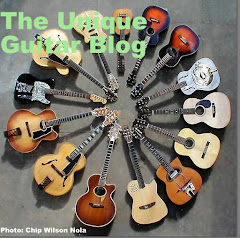The following is part of the transcript from the Antiques Roadshow web site:
GUEST: My great-uncle used to play live on the radio. "Cowboy Slim" is what he went by. And in 1952 a buddy of his wanted to sell him this guitar. Initially he didn't have the money, he didn't want to buy it. His friend told him to pay him when got the money, so he paid him the $50 when he got the money. And he passed away in December of 1989, and then I got it.
APPRAISER: Have you had the guitar appraised, have you had it evaluated?
GUEST: Yeah, years ago, in the early '90s. They appraised it from pictures that I sent off, and they said around $10,000. And they were interested in buying it if I wanted to sell it, which seemed unusual.
APPRAISER: You didn't sell it. Well, that's probably a good thing.
This is a C.F. Martin guitar. C.F. Martin guitars started in New York City in 1833. By the time this guitar was made, they had moved to Nazareth, Pennsylvania, where they are today.
It's a 42 style. 42 means that it has the pearl around the body. It doesn't have the pearl around the back and sides. It's also called the 000. That's the body size. This guitar was made in 1941. 1942 was the World War. They quit making fancy things for a while. So 1942 was the last year that they made this model. They did make a fancier model. They made a 000-45. But, for some reason, the 000-42 has become the rarest and hardest to find of the pearl guitars. It was kind of the poor man's pearl guitar. It was an inexpensive guitar from day one, but it only had the pearl on the front.
The tuners that they used back in the '30s, which was kind of the golden era of Martin guitars, weren't available during the war, so they used a lower grade tuner.
The fact that it has these lower grade tuners and somebody didn't go back later and put more expensive tuners on it is really a good thing, because that preserves the originality of the guitar. I'm going to go back to the front of the guitar. It has an ebony bridge and ebony fretboard that's bound in ivoroid. This is the nicest example of this guitar I have seen.
I did a little research on this guitar. One thing not mentioned is the headstock is overlaid with Brazilian rosewood. The quality of the workmanship is superb.
The wood on these older models has aged well. Some of the models from these years may have used actual ivory for binding material.
In the 1990's Martin designed a guitar for Eric Clapton, which he used on his Unplugged CD. This was the 000-42EC. This guitar featured a solid Carpathian spruce top polished with vintage toner. The back and sides were made of solid Madagascar rosewood. The neck was mahogany and designed with a modified V shape.
The headstock was overlaid in rosewood.
The tuners were made by Waverly; Nickel with Ivoroid butterbean knobs.
The guitar had abalone inlay on the body and ivoroid trim. Unlike the 1940's models, this guitar had trim on the back of the body and an ivoroid stripe down the middle of the back.
The snowflake position marker were deluxe and the headstock featured an exquisite design. I believe this was a limited edition of 250 guitars. They were hand signed by Clapton. The action was set high from the factory, but perhaps this is due to Clapton's preference.
This guitar is similar to the newer models; however the back is Indian rosewood and the top is sitka spruce. The binding is a material called Bolatron and is black and white. The neck is bound in white ivoroid.
The nut is real bone as is the compensated bridge saddle. The fingerboard is black ebony with snowflake markers (all of these instruments feature snowflake markers unless otherwise specified). The tortoise shell pickguard is beveled.
Like all the aforementioned 000-42's this guitar had 20 frets, joining the body at the 14th fret.
However there are 000-42's that join at the 12th fret.
Like older Martins there is no paper label. The model number was burnt into the back center woodstrip and on the neck block.












2 comments:
Hey y'all, not sure if this thing is still an active blog or not but I figured I would share what I've got. The transcript that you have included is actually from the episode with my father when he took his martin to the roadshow to have it appraised. We both love playing guitar and I am lucky enough to have played it, and can also confirm that we still have it to this day and never sold it. Sadly, I cannot find any videos showing his time on the show and I've spent hours scouring the internet and have only found the video of the woman with her husbands guitar.
Your choice of words does not sound like either of my kids, but this transcript is from when I was on the Antiques Roadshow in Denver in 2012. Unfortunately I am only able to find the leader for the episode.
https://video.pbsnc.org/video/antiques-roadshow-denver-co-hour-three-preview/
Post a Comment